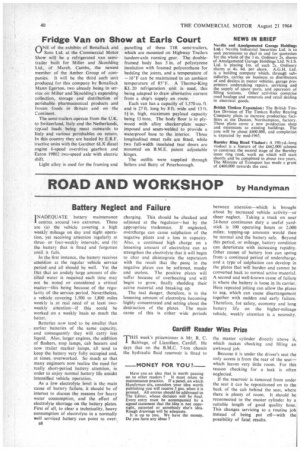ROAD AND WORKSHOP by Handyman
Page 44

If you've noticed an error in this article please click here to report it so we can fix it.
Battery Neglect and Failure
I NADEQUATE battery maintenance centres around two extremes. These are (a) the vehicle covering a high weekly mileage on day and night operation, yet receiving attention regularly at threeor four-weekly intervals; and (b) the battery that is fitted and forgotten until it fails.
In the first instance, the battery receives attention at the regular vehicle service period and all should be well. Yet the fact that an unduly large amount of distilled water is required each time may not be noted or considered a critical matter—this being because of the regularity of the service period. Nevertheless, a vehicle covering 1,500 to 1,800 miles weekly is in real need of at least twoweekly attention—if this could be worked on a weekly basis so much the better.
Batteries now tend to be smaller than earlier batteries of the same capacity. and consequently they will carry less liquid. Also, larger engines, the addition of flashers, stop lamps, cab heaters and now trailer marker lamps, all tend to keep the battery very fully occupied and, at times, overworked. So much so that many engineers now realize the need for really short-period battery attention, in order to enjoy normal battery life amidst intensified vehicle operation.
As a low electrolyte level is the main cause of battery failure, it should be of interest to discuss the reasons for heavy water consumption, and the effect of electrolyte shortage on the battery plates. First of all, to clear a technicality, heavy consumption of electrolyte in a normally well serviced battery can point to over a8
charging. This should be checked and adjusted at the regulator—but by the appropriate tradesman. If neglected, overcharge can cause sulphation of the negative plates and a loss in capacity. Also, a continued high charge on a lessening amount of electrolyte can so strengthen the electrolyte that it will begin to char and disintegrate the separators with the result that the paste in the negative plates can be softened, mushy and useless. The positive plates will suffer because of overheating and will begin to grow, finally shedding their active material and breaking up.
The real danger, therefore, is in the lessening amount of electrolyte becoming highly concentrated and setting about the destruction of the plates. The main cause of this is either wide periods between attention—which is brought about by increased vehicle activity—or sheer neglect. Taking a truck on near 24-hour continuous duty a useful yardstick is 100 operating hours or 2,000 miles; topping-up amounts would then be normal and the battery safe. Beyond this period, or mileage, battery condition can deteriorate with increasing rapidity. Other causes of battery loss can spring from a continued period of undercharge, and a type of sulphation can develop in the plates that will harden and cannot be converted back to normal active material. A second and well-known cause of failure is where the battery is loose in its carrier. Here repeated jolting can allow the plates to sag, which can cause disarrangement together with sudden and early failure. Therefore, for safety, economy and long battery life on the higher-mileage vehicle, weekly attention is a necessity.






















































































































